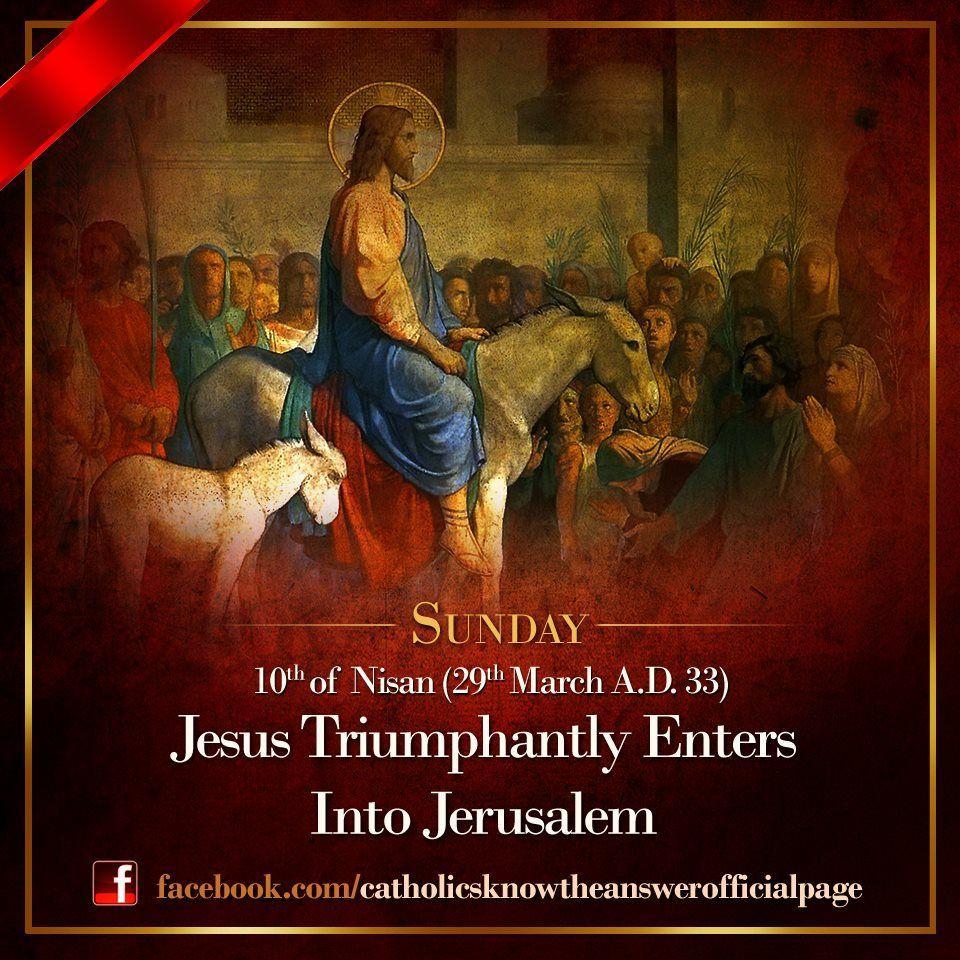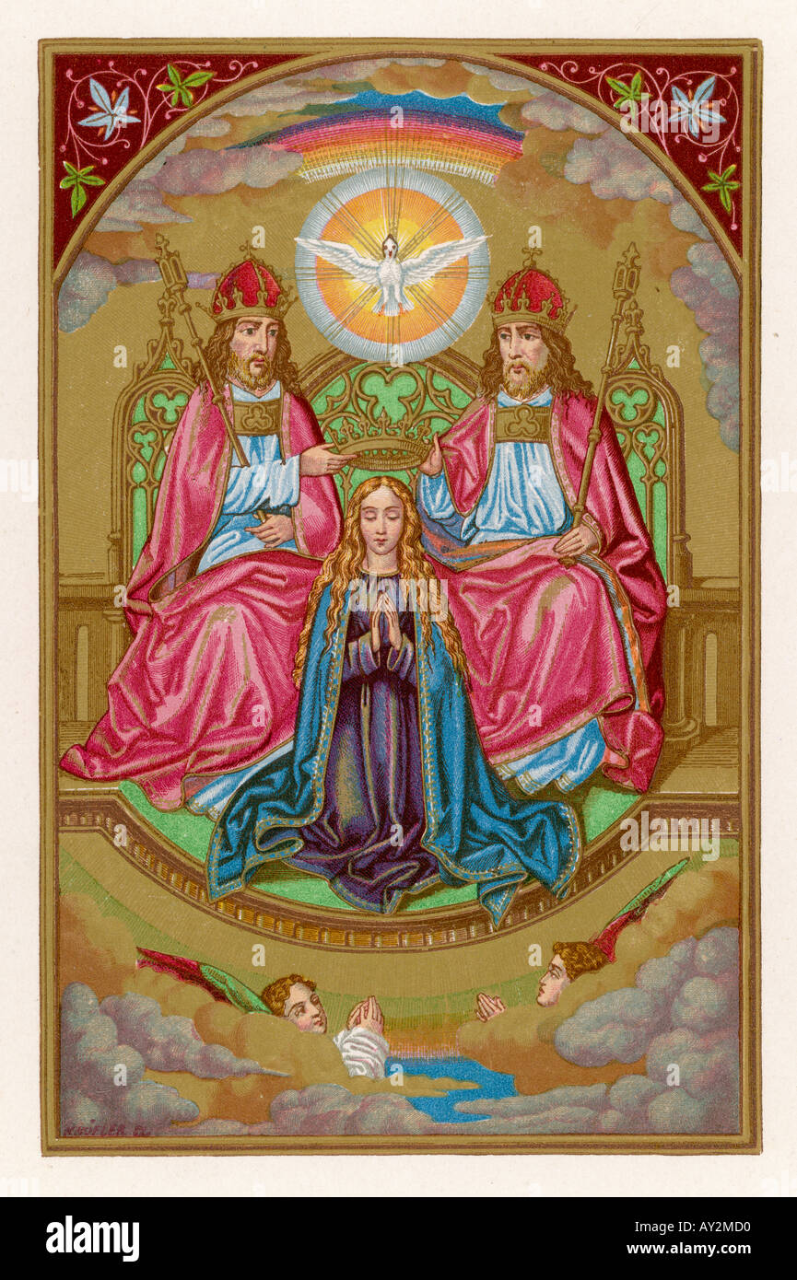All Activity
- Today
-

Trad wife movement vs working wives
Anastasia13 replied to Anastasia13's topic in Catholic Debate Table
I don’t understand. What does saying this have to do either with them being prepared if they become widows? - Yesterday
-
Palm Sunday is designed to reflect the dramatic mood swing that accompanies the events of that day when Jesus was triumphantly welcomed into Jerusalem, only to face his rejection and crucifixion a few days later. We are here now to make our answer to the invitation of Palm Sunday. Jesus is hailed by the crowds today, And then we have a choice. Many of us will go home and not darken the door of spiritual encounter until Easter Day. But that is a mistake. He has spent three years on Earth teaching, healing, leading people to God, to liberation, to new life. Today, on Palm Sunday, we all shout out his name with Hosannas. He is clearly top of mind. But he knows that the time is fast approaching when all will desert him, along with the rest of the disciples. That is exactly what the chief priests and scribes want. We read in the Gospel of Mark, “The chief priests and the scribes were looking for a way to arrest Jesus by stealth and kill him, for they said, ‘Not during the festival, or there may be a riot among the people.’” They don’t want people holding on to their allegiance to Jesus. It’s too dangerous. The Romans are already losing patience with the Jews and their ongoing parade of political Messiahs who cause disturbance and unrest. And Rome solves its problems with violence. The chief priests and scribes know that everyone will be better off, safer if Jesus is simply forgotten. And that’s the question we’re being asked today. When we walk out of these doors will we forget Jesus? Will we abandon him? Will the noise and news, claim our attention for the next seven days, so that the Resurrection is an anti-climax marked only by Easter eggs? That can’t be all we have to offer. That can’t be all the courage we have. Try to stand in Jesus’ shoes at this moment, on Palm Sunday, toward the end of the day. The crowds welcomed him into Jerusalem, waving palms and laying their cloaks in the road before him. Everyone was joyful, exuberant. The disciples felt like their moment finally had come; Jesus was going to take over Jerusalem and show the Romans who was boss. Now it’s the end of the day. The crowds have gone home and the pilgrims and others from outside the city like the disciples have found rooms at inns or courtyard corners to bed down in. And where is Jesus? The colt has been handed off to someone, and the hundreds surrounding him have dwindled to the Twelve, the women, and a few other friends and followers and no one notices Jesus drifting away out of the warm circle of firelight to stand alone, gazing out at the quieting city under the stars. This is where Jesus is at the end of the day on Palm Sunday. The task that lies before him is overwhelming, and he knows that one by one, everyone will abandon him until he is all alone. But the thing is that we still have a chance. We still have a choice. We can decide that we will be loyal to Jesus to the best of our ability, every day of this week that changed the world. It may be through coming to worship. It may be through extra time in prayer and meditation every day of Holy Week. It may be through serving others who are in need, or reading the entirety of one of the gospels, or finishing our Lenten intention with special dedication and love. It doesn’t matter what we do to follow Jesus to the Cross. It just matters that we do something. It will be difficult. Living Holy Week fully, with integrity, demands that we have to trust Jesus and follow him into the shadows, for the sake of the promise of the light. If we say yes to the invitation of Palm Sunday, we are committing to being trapped somewhere between the wrenching fear and despair of losing faith, and the ultimate promise that the resurrected Christ will shine forth over the world with love that heals and reconciles all people. We say yes to being stuck between those two poles for seven long days. Let’s try to remember Jesus and stay with him from now until Easter Day, because he is not a dead man at all. And that’s all we need to know to get through these days as we wait for the light—he is alive. Following His example of humble obedience in the trials and crosses of our lives, we know we will never be forsaken, that one day we too will be with Him in Paradise (Luke 23:42).
-

Trad wife movement vs working wives
little2add replied to Anastasia13's topic in Catholic Debate Table
Hence, the importance of the sacrament of holy matrimony. -

Trad wife movement vs working wives
Anastasia13 replied to Anastasia13's topic in Catholic Debate Table
That’s exactly my thinking. I see this trend with these women who will be totally unprepared if that happens. The only thing they have going for them is their social media and hopefully life insurance. -

Great/grate Veils Of The Discalced Carmelite Nuns
graciandelamadrededios replied to graciandelamadrededios's topic in Catholic Vocation Station
When the Sisters accompanied a workman within the enclosure - she rings the handbell to warn that the Sisters to stay away or stay in their cells. If this is not possible, the Sisters has to pull down her veil in front of her face. -
Gloire au Père et au Fils et au Saint Esprit, comme il était au commencement, maintenant et pour les siècles des siècles. Amen
- Last week
-
I have no news to post at just this moment, but we are heading into ordination season, so... let the good news begin!
-
I certainly can, although no one needs my permission to start a thread. I'll do that now.
-
2024 Entrances, Vows, and Ordinations
Franciscan Mike replied to Luigi's topic in Catholic Vocation Station
ARE YOU STARTING A NEW PAGE FOR 2025 LUIGI? -
Oh mon Jésus, pardonnes-nous nos péchers, préserves-nous des feux de l'enfer, conduisez au ciel toutes les âmes, psécialement celles qui ont le plus besoin de Ta miséricorde. Amen Salut, Ô Reine, mère de miséricorde, notre vie, notre douceur et notre espérance, Salut! Enfants d'Eve, exilés, nous crions vers vous; vers vous nous soupirons, gémissant et pleurant dans cette vallée de larmes. Ô vous, notre avocate, tournez vers nous vos regards miséricordieux. Amen Notre Père, qui est au cieux, que Ton nom soit sanctifier, que Ton règne vienne, que Ta volonté soit faite sur la terre comme au ciel. Pardonnes-nous nos offenses, comme nous pardonnons aussi a ceux qui nous ont offensé, ne nous soumets pas a la tentation, mais délivres nous du mal. Amen
-

The Habit Of Poor Clare Colettines Before Vatican Ii
graciandelamadrededios replied to graciandelamadrededios's topic in Catholic Vocation Station
I did ask the Mother Prioresses and they have differing opions - one said it could be a Muslim Influence and another said the opposite. Carmelite Nuns sent the following explanation to a friend: We assume that what you call the Great Veil, is actually the Parlor Veil that you are referring to. In the times of Our Holy Mother St. Teresa, she and other cloistered nuns would wear these veils covering their faces completely when meeting persons outside the cloister, particularly on her journeys when setting up new foundations of Carmelite Nuns. The purpose of these parlor veils was to maintain the spirit of the cloister even when certain duties were necessary to perform outside the cloister. This spirit was and continues to be a spirit of detatchment from the things of the world and being set apart from the world in order to maintain intimate converse with their Spouse, Jesus Christ. Carmelite life is also a hidden life, and St. Teresa tried to even maintain this aspect of our life in tact when one needed to leave the enclosure. It also helps maintain recollection, custody of the senses, and maintaining religious decorum outside the monastery. In the days of St. Teresa, this was a very common practice and widely accepted as the norm since all of Europe was still predominately Catholic. In our modern times, however, this is not the case and that is why this pious practice has almost become extinct among Carmels today. I have a copy of "Carmel: Its History, Spirit, and Saints" compiled by The Discalced Carmelites of Boston and Santa Clare, published in 1927. It says that Pope Urban IV made the regulation that in all monasteries, each grate should be armed with points of iron. St. Charles of Borromeo, during the Council of Milan, approved and generalized the use of double grate as ordained by St. Francis of Paula for his religious and even designated the distance which should separate one from another. He also wished the Religious to have their faces covered with a veil before persons from without, who should be obliged to enter into the cloister. PAPER OF EXACTIONS OF THE Discalced Carmelite Nuns OF THE ORDER OF OUR LADY OF MOUNT CARMEL taken from the traditions of our Spanish Mothers and Foundresses. When they have to see the doctor, they should have their great veil lowered and not raise it until they are told to do so, drawing it down again directly after, but when they have received Extreme Unction, they usually only wear the little veil. They only speak to the doctor when the Mother Prioress, or the Sub-prioress, and in their absence, the Infirmarian tells them to do so; the latter will take care to be beforehand with this permission as soon as the doctor questions them. They should edify him by their patience and moderation, contenting themselves with saying what he wishes to know, without showing any eagerness for the remedies which are pleasing to nature, or aversion for those of which it is in dread. Great/grate Veils Of The Discalced Carmelite Nuns the above is a VS old thread about the great/grate/parlour/enclosure veils with many photos. -
@dUSt While it's not specifically Catholic, I did find a Christian Hip Hop station that I think you and others here might appreciate: https://myboostnation.com Enjoy!
-
The Habit Of Poor Clare Colettines Before Vatican Ii
Hna.Caridad replied to graciandelamadrededios's topic in Catholic Vocation Station
I wonder how much of this (especially face-covering, but also the use of mantillas) has to do with the Muslim influence in Spain? I really don't see mantillas on women or chin-covering on nuns when I look at Renaissance-era paintings, which has me thinking that women in Italy at that time probably weren't wearing them. -
S5.10 Je vous salut Marie, pleine de grâce, le Seigneur est avec vous, vous êtes bénie entres toutes les femmes et Jésus, le fruit de vos entrailles est béni. Sainte Marie, Mère de Dieu, priez pour nous pécheurs, maintenant et a l'heure de notre mort. Amen
-

The Habit Of Poor Clare Colettines Before Vatican Ii
graciandelamadrededios replied to graciandelamadrededios's topic in Catholic Vocation Station
You are referring to the enclosure veil, a black large thin veils that covers their faces when a Nun is out of the enclosure, they are within the enclosure grounds but might be seen by outsiders, or when a nun is speaking to a person in the parlor who is not an immediate family member - the curtain or stutters of the grate is open, then they pulled down the veil. Discalced Carmelite Nuns refers to this type of veil as grate or great veils. Novices wore a white thin veil covering their faces. I correponded with Mother Prioress of one of the 1990 Carmels in the US and she shared that in her community, the no longer wear the veil down to their chest but the pulled it down to their nose. You can still see the lips of the Nuns. Not every 1990 Carmels does this but I think majority if not all 1990 Carmels in Spain pulls down their veils down to their noses. If you can find a photo during the burial of Mother Maravillas of Jesus, you will be able to see how the nuns wore their veils. -
S5.9 Je vous salut Marie, pleine de grâce, le Seigneur est avec vous, vous êtes bénie entres toutes les femmes et Jésus, le fruit de vos entrailles est béni. Sainte Marie, Mère de Dieu, priez pour nous pécheurs, maintenant et a l'heure de notre mort. Amen
-
The Habit Of Poor Clare Colettines Before Vatican Ii
GraceUk replied to graciandelamadrededios's topic in Catholic Vocation Station
I read that face coverings were worn when travelling. I think it was in A Right to be Merry that a train journey was described and the sisters wore face veils. I wonder when this custom was ended. I expect after Vatican II. I wonder if novices and postulants wore them. Probably not as I think it might have been something to do with enclosure. -
S5.8 Je vous salut Marie, pleine de grâce, le Seigneur est avec vous, vous êtes bénie entres toutes les femmes et Jésus, le fruit de vos entrailles est béni. Sainte Marie, Mère de Dieu, priez pour nous pécheurs, maintenant et a l'heure de notre mort. Amen
-
LOL! It's all so funny 'cause it's all so true!
-
S5.7 Je vous salut Marie, pleine de grâce, le Seigneur est avec vous, vous êtes bénie entres toutes les femmes et Jésus, le fruit de vos entrailles est béni. Sainte Marie, Mère de Dieu, priez pour nous pécheurs, maintenant et a l'heure de notre mort. Amen
-

The Habit Of Poor Clare Colettines Before Vatican Ii
graciandelamadrededios replied to graciandelamadrededios's topic in Catholic Vocation Station
THE RULE OF ST. CLARE AND THE CONSTITUTIONS FOR POOR CLARE NUNS OF THE REFORM OF ST. COLETTE 1932 CHAPTER II. Of the Quality of the Habit and of the other Garments 20. - Since the Rule of Form of life lays down that the Sisters be clothed with poor garments, we ordain and decree that this poverty, both with respect to price and colour, be attended to. 21. - Although it is laid down in the Form of life that the Abbess shall supply and provide the person who enters, on her laying aside her secular dress, with three tunics and a mantle, nevertheless, if necessity or infirmity, or any circumstances of person or of place or time should cause any one to need more garments, we declare that the Abbess shall provide the Sisters with garments according to the qualities according to the qualities of persons and places and times and cold climates, as necessity may seem to require. 22. - It is to be understood that the three tunics mentioned in the Form of life need not be of the same form or shape, since the two inner tunics are allowed, not so much as being part of the Habit of the Order as for the comfort and heat and decency of the body; nor need they be of the same colour. 23. - Wherefore, we direct and ordain that the outer tunic be designated as the Habit of the Order, without which the Sisters may not appear in public, nor retire to sleep, unless illness or infirmity or any other manifest necessity, which has been declared to be sufficient either by the Abbess or her Vicaress, should warrant them to act otherwise. 24. - Let the length of the habit be such that, when worn, it shall not exceed the stature of the person who wears it and train along the ground; and the width shall not exceed fourteen palms. The sleeves shall not extend beyond the first finger joints. 25. - The inner tunics shall be of poor cloth, and may not be lined with skins or furs. 26. - The mantle also shall always be of poor and course cloth, and shall not be gathered or pleated about the neck; nor so long as to train in anyway along the ground. 27. - Let plainness, austerity and poverty, both with respect to texture, cost and colour, be always apparent in all the garments of the Sisters. 28. - Let all the Sisters, both the Abbesses and other Officials, be clad with the same common cloth, and let all partiality be excluded. 29. - The cord, with which the Sisters are girt, shall be plain and common, and shall be free from all manner of singularity. 30. - For the rest, with regard to the covering of the head, we prescribe and ordain that all the Sisters, both the Abbesses as well as the other professed members, without any distinction whatever, shall in all humility, modesty and piety, cover their heads and avoid singularity and vanity of all kinds. 31. - That this be the better observed at all times and by all Sisters in their Convents in every place, we decree that all the Sisters shall so adjust their kerchiefs, that the forehead, both cheeks and the chin shall be for the greater part covered, so that their faces may be in no wise entirely seen. 32. - Besides, the veils and all the kerchiefs that are worn on the head and about the neck shall be so arranged that they cover all the head, the greater part of the chest and the corresponding part of the body at the back. 33. - Furthermore, we direct that all veils and kerchiefs be of common, course and plain linen, so that the holy poverty and austerity of their profession may ever shine forth in them. 34. - Moreover, in order that cleanliness be always attended to, we declare that each Sister, with the consent and permission of her Abbess, may have two black veils and two or three changes of white kerchiefs. 35. - Let all the Sisters beware lest they have pleated kerchiefs, or kerchiefs of silk or of any other costly material. 36. - Finally, no novice may wear the black veil before she has made her profession, but she shall wear the white kerchiefs, suitably arranged according to the direction of the Abbess, as has been heretofore the custom. -
S5.6 Je vous salut Marie, pleine de grâce, le Seigneur est avec vous, vous êtes bénie entre toute les femmes et Jésus, le fruit de vos entrailles et béni. Sainte Marie, Mère de Dieu, priez pour nous pécheurs, maintenant et a l'heure de notre mort. Amen
-
S5.5 Je vous salut Marie, pleine de grâce, le Seigneur est avec vous, vous êtes bénie entres toutes les femmes et Jésus, le fruit de vos entrailles est béni. Sainte Marie, Mère de Dieu, priez pour nous pécheurs, maintenant et a l'heure de notre mort. Amen
- Earlier
-
“I believe nothing can happen that will outweigh the supreme advantage of knowing Christ Jesus my Lord. For him I have accepted the loss of everything, and I look on everything as so much rubbish if only I can have Christ and be given a place in him.” These are very autobiographical lines from St Paul, who once thought he had all the answers, but found out differently on the road to Damascus. Now St Paul is not really saying that the good things of life are not good, but it’s the comparison all else pales in significance when you look at what knowing Christ, gaining Christ, gives us. This is the goal of life. Other things can be a part of that, can even contribute to that goal. Insofar as they do, then we should enjoy them as gifts from God. But insofar as they get in the way, distract us, even take the place of Christ in our life, then we must count them as loss, dump them in the trash, so to speak. Also, as we all we know well, even the good things of life, gifts of God for our enjoyment, are perishable. Natural disasters, death, or even loss of family and loved ones, our own physical frailties and impending deaths are inevitable. As the Jesuit philosopher and theologian Pierre Teilhard de Chardin wrote in The Divine Milieu: “there still remains that slow, essential deterioration which we cannot escape old age little by little robbing us of ourselves and pushing us towards the end. It is indeed true that only Jesus Christ is the same, yesterday, today, and forever.” What is it that really matters? ‘All I want is to know Christ and the power of his resurrection and to share his sufferings by reproducing the pattern of his death.’ writes St. Paul. Note that the power is in the resurrection of Christ. During Holy Week we will be focusing on Jesus’ passion and death, and that is a necessary part of our journey to Easter. But even in the heart of Lent, we must not lose sight of the fact that we are Easter people. It has been said, truly, that you cannot have Easter without Good Friday. But Good Friday wouldn’t be as good if it weren’t for Easter. If Jesus had simply suffered and died, and that was the end of the story, why would we want to share in his suffering? In fact, if we were putting our trust in a Christ who was not raised from the dead, we would be, as Paul tells us in another passage, “of all people most to be pitied.” How are we to share in his sufferings? Perhaps during Lent, we have practiced some kind of fasting in the kinds or quantities of food we eat, or in our enjoyment of some other pleasures. Or perhaps we have chosen instead to take on some spiritual discipline for this holy season. This is a very small way to share in Christ’s suffering, to become like him in his death. Perhaps we need simply to die a little to ourselves to focus on others and not just on our own concerns and the concerns of those near and dear to us. Jesus said that whatever we do to the least of his brothers and sisters we do to, or for, him. It’s not too late to make that a part of our Lenten practice. In fact, we can and should do it anytime, no matter what the season. Finally, St Paul tells us, “All I can say is that I forget the past and I strain ahead for what is still to come; I am racing for the finish, for the prize to which God calls us upwards to receive in Christ Jesus.” What lies behind is done. Maybe we have done some really good things in our life. Maybe we, have done some really good things this Lent. If so, that is fine and appropriate, or maybe we haven’t done such a good job this Lent. Maybe we had good intentions but didn’t follow through with them. Maybe, in fact, we fell flat on our faces. Maybe there are sins in our past lives that are dragging us down. Well, nevertheless, there is Good News: we can put all that behind us, too. With the woman in the gospel, we’re invited to take a first step towards forgiveness, towards a renewed relationship with each other and with God. So, whatever we’ve done or failed to do this Lent, whatever we’ve done or failed to do our whole lives long, there is just one thing we need to do now: forget what lies behind and strain forward to what lies ahead. We’re invited to experience the joy of reconciliation in Lent; to experience a change of heart, so we might see a new deed come to light, a vision of new life, which the prophet Isaiah speaks of in the first reading. And this new life doesn’t simply depend on our own effort, which St Paul powerfully affirms in the second reading, but is God’s gift to us, in Jesus: we have only to receive him into our lives.





